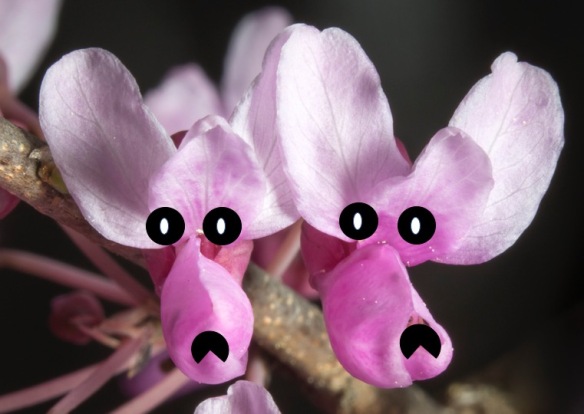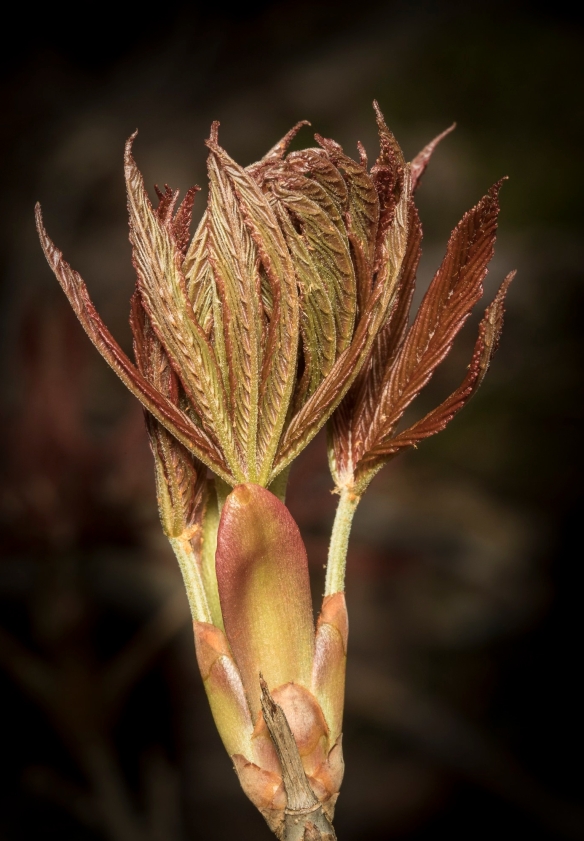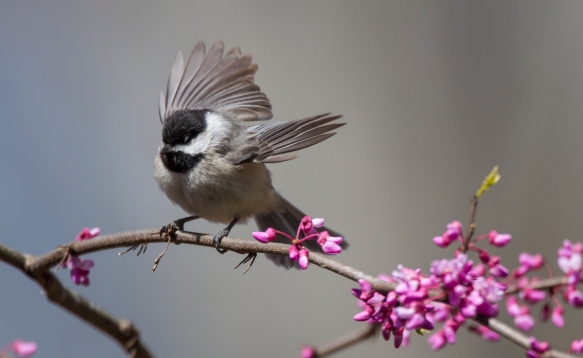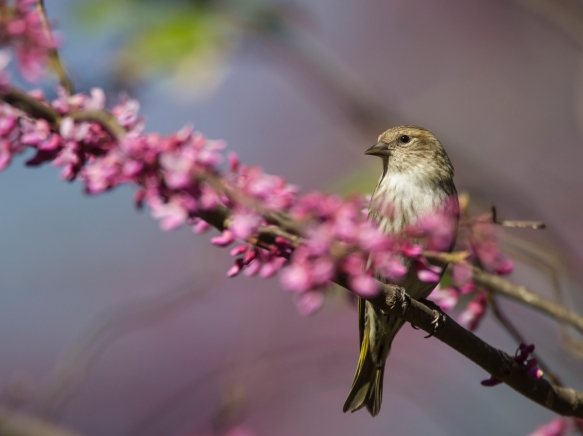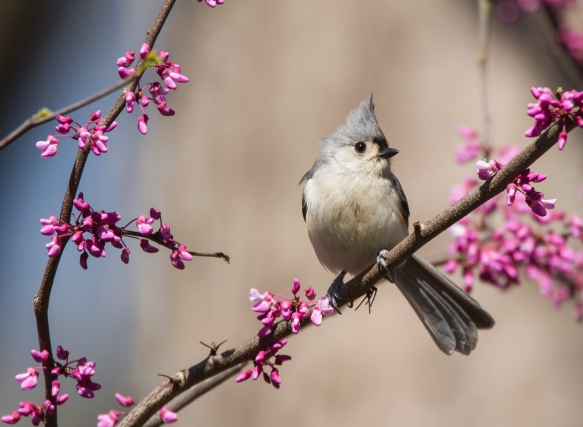The incredible but annually commonplace change that is life eternally renewed has begun to stir.
~Hal Borland
My last post dealt with the rapid changes in weather from the first spring wildflowers in our yard to the switch to bitter cold and time for chopping more firewood. The vagaries of “spring” weather really hit home when I went to visit my mother over the weekend and it snowed two inches overnight. Back at home earlier this week, I looked out the window and saw butterflies! I actually saw my first butterfly of the season last week, but didn’t manage to get out to get a photo before it disappeared. Tuesday, it was the same species, and not just one, but two, American Snout butterflies, flitting about the yard interacting, resting, and nectaring at one of the few flowers to be found, the diminutive yellow blossoms of Northern Spicebush.

American Snout butterfly, Libytheana carinenta (click photos to enlarge)
This is one of my favorite, and certainly one of the more bizarre, local butterflies. I don’t remember seeing them before as my first butterfly of the season, and here were two chasing each other around. After a brief bout, they separated with one going to spicebush flowers, the other settling on a post in the garden. I grabbed the camera and went out to try to document the event, but, at first, they were having none of it and were difficult to approach. That surprised me a bit as I have described this species to folks as “the friendliest butterfly” around. They have a habit of landing on people to imbibe our salty sweat and being somewhat fearless in doing so. I have had this happen several times in places where they congregate at puddles or other moist soil sites to gather minerals.
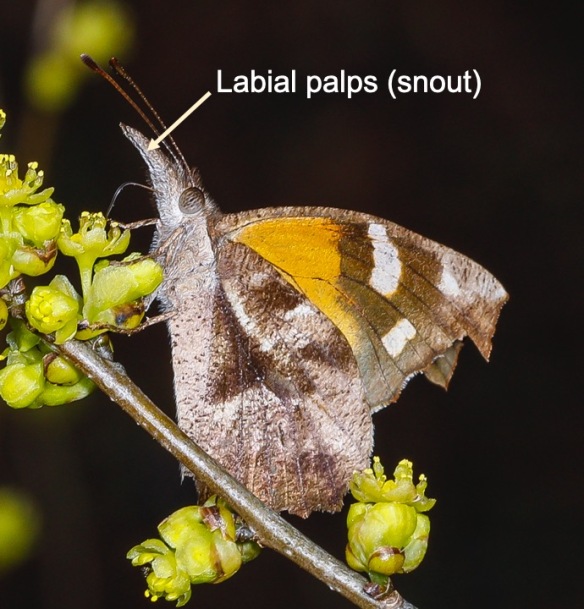
The common name comes from the enlarged labial palps, which give the appearance of a long snout.
I finally positioned myself and stood still, waiting for one to return to the tiny yellow flowers. That paid off and I was rewarded with several minutes of close observation. When I did a little research on my “nosy” neighbors, I was surprised to learn that this species overwinters as an adult, and thus is often one of the earliest butterflies seen. The large palps (part of the mouthparts of all butterflies, but greatly elongated on this species) that give the American Snout its name are believed to provide some additional camouflage for this unusual creature. This species often rests on a twig, head upward, snout and antennae touching the twig. Look at that first picture again and imagine it is not on the flower but on the twig. The brown coloration of the underwings resembles a dried leaf. When the snout and antennae rest on the twig, they resemble a leaf petiole, so when this guy stops and rests on a twig, it virtually disappears as dead background vegetation!

The squared off shape of the edge of the forewing is also characteristic of this species.
American Snout caterpillars feed exclusively on species of Celtis (Hackberry and Sugarberry in our area) and are more common in hardwood forests, especially near bottomlands. In the southwest, they occasionally undergo massive unexplained irruptions that can darken the sky and have been estimated to number in the millions. I was thankful to have just these two to brighten my day.

A Calligrapher Fly, Toxomerus sp.
While waiting for the snouts to land near me, I started noticing some other early spring visitors to the spicebush. A few syrphid flies were buzzing around and collecting nectar or pollen. I got a close look at one and believe it is a member of the genus Toxomerus. The genus name comes from the Greek, taxon, bow, and meron, thigh, and refers to the bow-shaped leg segment (femur) which can be seen in this photo. The other characteristic of this group is the V-shaped notch along the trailing edge of the eye (again, visible in this picture). These flies are wasp/yellow jacket mimics, but are harmless.

An Asian Lady Beetle (ladybug), Harmonia axyridis. I didn’t notice the small spider nearby until I looked at the image on my laptop.
Asian Lady Beetles (also commonly called Multicolored Asian Lady Beetles) are a highly variable (in color and pattern) species originally from eastern Asia. One key to identification is that they generally have a white pronotum (the shield behind the head) with what looks like an M or W showing. They have been intentionally released in various states since the early 1900’s as a biological control of aphids, but it wasn’t until the 1980’s that the species really took off nationwide. They are considered a pest by many for their habit of overwintering inside dwellings and their impact, through predation, on many of our native ladybug species.

A dainty Summer (?) Azure, Celastrina neglecta
My second butterfly species of the season caught my eye as a tiny light blue speck flitting across the yard and then landing on a dead leaf on the ground. I assumed it was a Spring Azure, but was unable to approach close enough for a photo. Once again, I stood next to the blooming spicebush, and my quarry finally landed close enough for a portrait. When I went online to confirm its ID, I was reminded by several sources that the azures are a complex group of species that can be very difficult to sort out. My favorite source of information on butterflies in our state, the Butterflies of North Carolina, states that Summer Azures are more abundant and fly just as early as Spring Azures. The Summer Azure is considered the palest in color (both above and below) and in comparing images online, it seems like this one more closely matches the Summer Azure photos I saw. Of course, if any readers have an opinion, I’d love to hear it. This may be the best thing about retirement, the ability to take the time to observe and learn something new about the many incredible natural moments that happen right outside my door.








